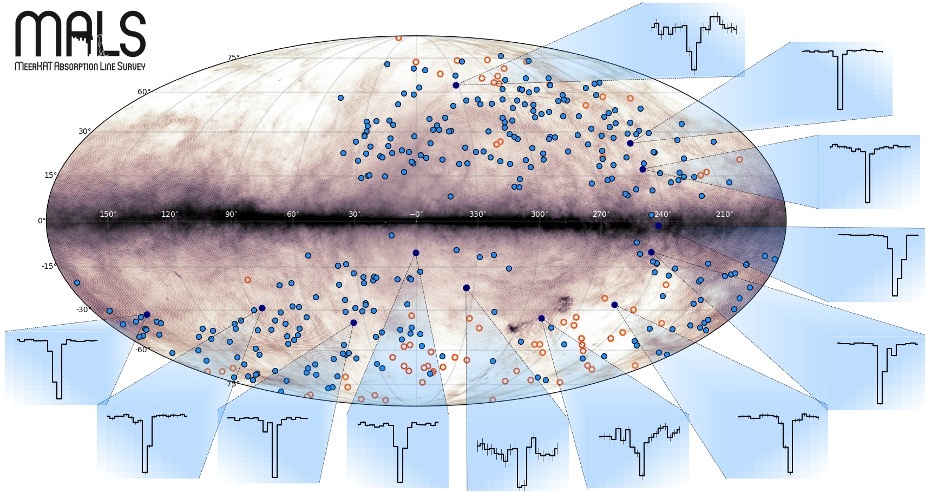9.05.2025

In this full-sky map presented in Galactic coordinates, the background shows the brightness of 21-cm line emission tracing both warm and cold components of hydrogen gas from the Milky Way galaxy as mapped by the HI4PI collaboration. The horizontal stripe at the center is the Milky Way disc. Also seen are filamentary structures of gas flowing in or out of the disc. The circles mark the positions of 391 MALS pointings containing a total of about 20,000 bright radio sources, typically supermassive black holes in the heart of galaxies located at cosmological distances. Also shown are examples of small absorption signals caused by cold hydrogen gas structures in the Milky Way. The combination of emission and absorption signals enables the exploration of gas physics in the Milky Way at unprecedented detail.
Using the data from the most sensitive radio telescope on Earth, the MeerKAT telescope in South Africa, an international team of astronomers has released the most comprehensive catalog of cold hydrogen gas in the Milky Way galaxy as part of the MeerKAT Absorption Line Survey (MALS; https://mals.iucaa.in/).
Such hydrogen atoms may eventually transform into molecular gas, the basic fuel for star formation. Therefore, these cold gas structures are key to the conditions that enable star formation and are of significant interest for astronomers. “This publicly released catalog will help us address a wide range of questions about the distribution of cold gas in the halo of the Milky Way and the processes through which galaxies convert gas into stars over cosmic time,” says Neeraj Gupta, astronomer at the Inter-University Centre for Astronomy and Astrophysics (IUCAA) in India and lead investigator of the MALS project, currently on sabbatical at NRAO in the USA.
A hydrogen atom consists of an electron and a proton. Through their interaction it can produce a spectral line in emission or absorption at a wavelength of about 21 centimeters. The strength of this 21 cm spectral line of hydrogen in emission is insensitive to temperature and hence traces both cold and warm components of the gas. In turn, the absorption signal is more sensitive to colder phases. Over the last several decades, many astronomical surveys have tried to map the complex structures of the gas in the Milky Way in emission at 21 cm wavelength. Still, the absorption line measurements require more sensitive measurements and hence remained sparse. MALS changes this fundamentally with about 3500 detections. “The simultaneous detection of this line in emission and absorption has the power to unravel the distribution of various thermal components and complex microphysics through which cold gas structures are formed,” explains Juergen Kerp, researcher at the University of Bonn in Germany for Multi-wavelength Studies.
Vast volumes of MeerKAT data were processed using a sophisticated processing pipeline and data storage facility set up at the IUCAA to generate the MALS catalog. The MALS team combined this catalog with the existing maps of 21 cm line emission, optical and far-infrared radiation to disentangle the distribution of the interwoven atomic gas phases. “These multi-wavelength data allow us to establish relationships between the properties of the thermal components of atomic gas and the local conditions such as radiation and turbulence generated by the release of energy from stars,” explains Sergei Balashev, researcher at the Ioffe Institute, St. Petersburg, Russia.
Follow this link to access the paper describing MALS data release 3: https://arxiv.org/abs/2504.00097.
The Galactic HI absorption line catalog and accompanying scientific results of this study are described in Gupta, Kerp, Balashev et al. (2025), accepted for publication in Astronomy & Astrophysics. This is the third of several radio continuum and spectral line data releases to come from MALS, and making this data release has been a team effort. The MALS catalogs and images are publicly available at https://mals.iucaa.in. The MALS team is an international collaboration of researchers from around the world. The project is led by N. Gupta from IUCAA, India. The MeerKAT telescope is a facility of the National Research Foundation (NRF) in South Africa and is operated by the South African Radio Astronomy Observatory (SARAO). The massive volume of raw survey data (1.6 petabytes) received from SARAO is hosted and processed at the IUCAA using an automated pipeline built at the IUCAA in collaboration with Thoughtworks Technologies India Pvt Ltd. It extensively utilises tools and tasks from the Common Astronomy Software Applications (CASA) software built by the National Radio Astronomy Observatory (NRAO) of the USA.
Quelle: South African Radio Astronomy Observatory
